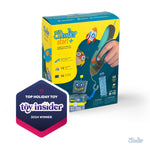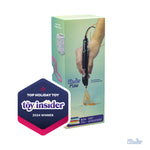Compound Words
In this lesson, students will work with a partner to put together words that create compound words. Each partner will then create a stencil to illustrate one of the words in the compound word and doodle it. Partners will weld their doodles together to create compound word doodles! This is a tactile and memorable way to understand and remember compound words.

KnowledgeStudents havehad practice recognizing, identifying and reading compound words.
reviewed the compound words used in this lesson, i.e., sunflower, jellyfish, football, toothbrush, fingernail, moonlight, rainbow, pancake.
had practice looking up words in a beginner's dictionary (online or real world).
had practice doodling outlines of shapes.
had practice doodling to fill in shapes.
had practice recognizing, identifying and reading compound words.
reviewed the compound words used in this lesson, i.e., sunflower, jellyfish, football, toothbrush, fingernail, moonlight, rainbow, pancake.
had practice looking up words in a beginner's dictionary (online or real world).
had practice doodling outlines of shapes.
had practice doodling to fill in shapes.
ObjectivesStudents willcreate a tactile system for remembering compound words.
match sets of compound words.
create stencils for each word in a compound word.
doodle each word in a compound word.
weld doodles together to create a compound-doodle as a model of a compound word.
understand that a compound word does not have the same meaning as each of the two words that comprise it.
create a tactile system for remembering compound words.
match sets of compound words.
create stencils for each word in a compound word.
doodle each word in a compound word.
weld doodles together to create a compound-doodle as a model of a compound word.
understand that a compound word does not have the same meaning as each of the two words that comprise it.
MaterialsStudents will need3Doodler (1 per pair)
Doodle Compound Word Match Worksheet (1 per pair)
pencil (2 per pair)
beginner's dictionary online or real world (1 for lesson)
3Doodler (1 per pair)
Doodle Compound Word Match Worksheet (1 per pair)
pencil (2 per pair)
beginner's dictionary online or real world (1 for lesson)
Lesson PlanInstructions
Step 1Whole group: Project your tablet or computer screen on the board to share the following words: sunflower, jellyfish, football, toothbrush, fingernail, moonlight, rainbow, and pancake. Review what makes these compound words.
Step 2Discuss the meaning of each compound word. Use an online or real world dictionary. Have students help you look up the meaning of each compound word.
Step 3Break each compound word into two words. Compare and contrast the definition of the compound word to the meaning of each individual word comprising it. Note the differences.
Step 4Project the Doodle Compound Word Match Worksheet on the board.
a) Instruct students to complete this activity by doodling a line to match each set of compound words.
b) Draw a stencil of each word on the left and right side of the table.
c) Doodle each stencil.
d) Weld stencils together.
Step 5Note that Partner #1 will fill in the left side of each table on the Doodle Compound Word Match Worksheet. Partner #1 will complete the right side of the each table. Partners will work together to weld each part of a compound word together to create a compound-doodle.
Step 6Model how to match one set of words. Draw a stencil for each. Doodle them. Weld them together. Each set of partners should end up with 8 compound-doodles.
Step 7Hand out one Doodle Compound Word Match Worksheet to each set of partners, along with a 3Doodler to share.
Step 8Circle to assist and assess.
Whole group: Project your tablet or computer screen on the board to share the following words: sunflower, jellyfish, football, toothbrush, fingernail, moonlight, rainbow, and pancake. Review what makes these compound words.
Discuss the meaning of each compound word. Use an online or real world dictionary. Have students help you look up the meaning of each compound word.
Break each compound word into two words. Compare and contrast the definition of the compound word to the meaning of each individual word comprising it. Note the differences.
Project the Doodle Compound Word Match Worksheet on the board.
a) Instruct students to complete this activity by doodling a line to match each set of compound words.
b) Draw a stencil of each word on the left and right side of the table.
c) Doodle each stencil.
d) Weld stencils together.
Note that Partner #1 will fill in the left side of each table on the Doodle Compound Word Match Worksheet. Partner #1 will complete the right side of the each table. Partners will work together to weld each part of a compound word together to create a compound-doodle.
Model how to match one set of words. Draw a stencil for each. Doodle them. Weld them together. Each set of partners should end up with 8 compound-doodles.
Hand out one Doodle Compound Word Match Worksheet to each set of partners, along with a 3Doodler to share.
Circle to assist and assess.
Wrap Up
Assessment
Possible Extensions
Vocabulary
compound words - a word composed of two or more words that create a new word when combined. Examples include pancake, two-tone and school bus.
creative thinking - a way of looking at problems or situations from a fresh and imaginative perspective.
definition - the meaning of a word, phrase, etc...
design - to prepare the preliminary sketch or the plans (for a work to be executed), especially to plan the form and structure of an object, building, bridge, etc...
language arts - the subjects (such as reading, spelling, literature, and composition) that aim at developing the student's comprehension and capacity for use of written and oral language.
literacy - the quality or state of being literate.
problem-solving - the process or act of finding a solution to a problem.
reading - the form or version of a given passage in a particular text.
sight words - commonly used words that young children are encouraged to memorize as a whole by sight, so that they can automatically recognize these words in print without having to use any strategies to decode.
spelling - the manner in which words are spelled.
vocabulary - the stock of words used by or known to a particular people or group of persons.
Educational Standards
Use knowledge of the meaning of individual words to predict the meaning of compound words (e.g., birdhouse, lighthouse, housefly; bookshelf, notebook, bookmark).
Students will recognize, compare and contrast the meaning of individual words in a compound word, along with the meaning of the compound word itself.
Use glossaries and beginning dictionaries, both print and digital, to determine or clarify the meaning of words and phrases.
Students will work along with the teacher to look up the meaning of compound words used in this lesson, i.e., sunflower, jellyfish, football, toothbrush, fingernail, moonlight, rainbow, pancake.
Decompose (break down) a larger problem into smaller sub-problems with teacher guidance or independently.
Students will break down the process of understanding compound words through a creative operation of designing, doodling, and welding.
Use technology to seek feedback that informs and improves their practice and to demonstrate their learning in a variety of ways.
Students will use a 3Doodler to create a tactile model of compound words, i.e., sunflower, jellyfish, football, toothbrush, fingernail, moonlight, rainbow, and pancake.
Use collaborative technologies to work with others, including peers, experts or community members, to examine issues and problems from multiple viewpoints.
Students will confer with a partner and whole group throughout this activity.





